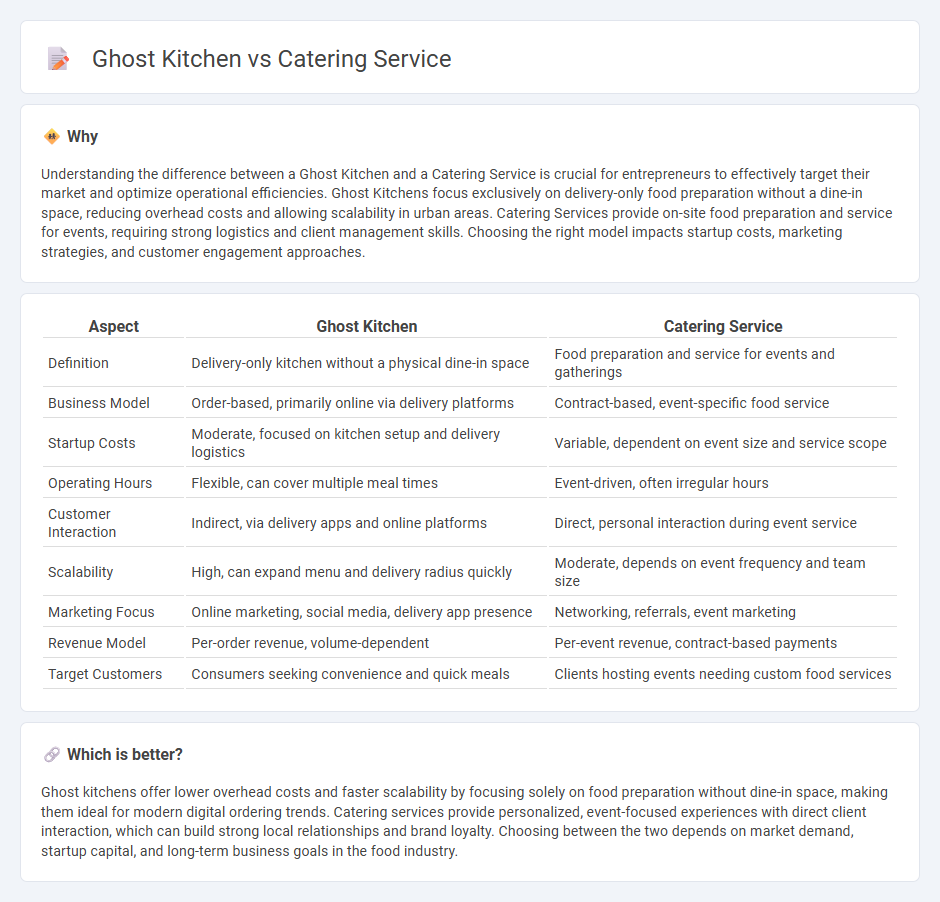
Ghost kitchens operate exclusively for delivery, leveraging cost-effective, tech-driven models to serve multiple restaurant brands from a single location, optimizing scalability and efficiency. Catering services focus on preparing and delivering food for events or large groups, often emphasizing personalized menus and on-site presentation to enhance customer experience. Explore the differences and benefits of both models to determine the best fit for your entrepreneurial goals.
Why it is important
Understanding the difference between a Ghost Kitchen and a Catering Service is crucial for entrepreneurs to effectively target their market and optimize operational efficiencies. Ghost Kitchens focus exclusively on delivery-only food preparation without a dine-in space, reducing overhead costs and allowing scalability in urban areas. Catering Services provide on-site food preparation and service for events, requiring strong logistics and client management skills. Choosing the right model impacts startup costs, marketing strategies, and customer engagement approaches.
Comparison Table
| Aspect | Ghost Kitchen | Catering Service |
|---|---|---|
| Definition | Delivery-only kitchen without a physical dine-in space | Food preparation and service for events and gatherings |
| Business Model | Order-based, primarily online via delivery platforms | Contract-based, event-specific food service |
| Startup Costs | Moderate, focused on kitchen setup and delivery logistics | Variable, dependent on event size and service scope |
| Operating Hours | Flexible, can cover multiple meal times | Event-driven, often irregular hours |
| Customer Interaction | Indirect, via delivery apps and online platforms | Direct, personal interaction during event service |
| Scalability | High, can expand menu and delivery radius quickly | Moderate, depends on event frequency and team size |
| Marketing Focus | Online marketing, social media, delivery app presence | Networking, referrals, event marketing |
| Revenue Model | Per-order revenue, volume-dependent | Per-event revenue, contract-based payments |
| Target Customers | Consumers seeking convenience and quick meals | Clients hosting events needing custom food services |
Which is better?
Ghost kitchens offer lower overhead costs and faster scalability by focusing solely on food preparation without dine-in space, making them ideal for modern digital ordering trends. Catering services provide personalized, event-focused experiences with direct client interaction, which can build strong local relationships and brand loyalty. Choosing between the two depends on market demand, startup capital, and long-term business goals in the food industry.
Connection
Ghost kitchens and catering services are connected through their shared focus on flexible food production without traditional dine-in spaces, enabling entrepreneurs to reduce overhead costs and scale operations efficiently. Leveraging ghost kitchens allows catering businesses to optimize meal preparation, manage multiple brands, and reach wider markets using delivery platforms and customized menus. This synergy enhances profitability and innovation in the food service industry by merging virtual kitchen models with specialized event catering needs.
Key Terms
Overhead Costs
Catering services often face higher overhead costs due to expenses like venue rental, staff wages, and equipment maintenance, whereas ghost kitchens operate with significantly lower overhead by eliminating dine-in facilities and reducing labor hours. Ghost kitchens leverage optimized kitchen spaces and technology to streamline food preparation and delivery, substantially cutting costs related to real estate and front-of-house personnel. Explore the detailed cost comparisons to understand which model aligns best with your business goals.
Delivery Model
Catering services typically prepare food in bulk for specific events, emphasizing personalized menus and on-site or scheduled delivery, whereas ghost kitchens operate solely for online orders, optimizing food production for rapid delivery through third-party platforms. Ghost kitchens reduce overhead costs by eliminating dine-in spaces, enabling faster order processing and scalability focused exclusively on delivery efficiency. Explore how each model impacts customer reach and operational strategy to choose the best fit for your business.
Customer Interaction
Customer interaction in catering services involves direct engagement, allowing personalized menu customization and immediate feedback, which enhances client satisfaction. Ghost kitchens operate primarily online with no physical storefront, limiting face-to-face communication but leveraging digital platforms for ordering and customer support. Explore how these models impact your dining experience and business growth strategies.
Source and External Links
Catering At Your Door | Delicious Maryland Catering Services - Offers diverse menus and catering services in Maryland, Virginia, and Washington D.C., specializing in family gatherings, corporate events, weddings, and more with fresh ingredients and interactive culinary presentations.
Catering Bethesda | Perfect Menus, Exceptional Service - Full-service catering in Bethesda, MD since 1998, providing customizable menus from beef to vegan options for weddings, corporate events, and private parties with professional service.
Chick-fil-A Catering - Provides convenient party trays, packaged meals, breakfast items, and more for a variety of group sizes to simplify event meal planning with popular Chick-fil-A menu items.
 dowidth.com
dowidth.com